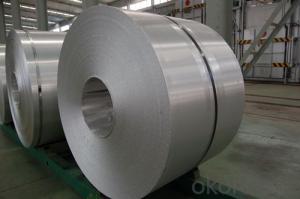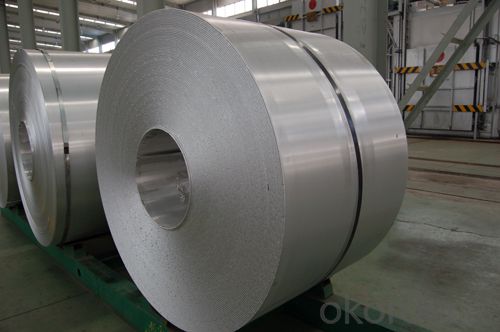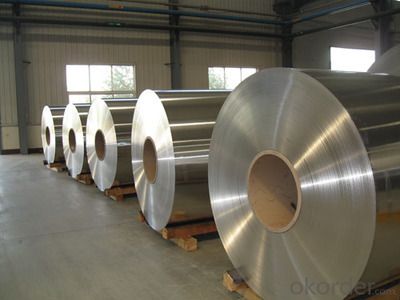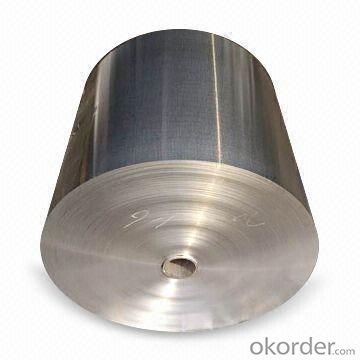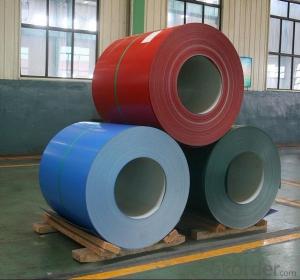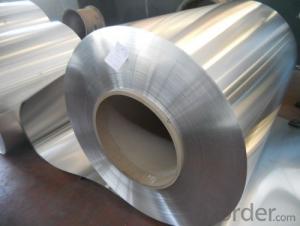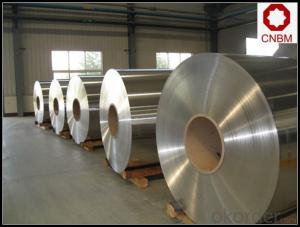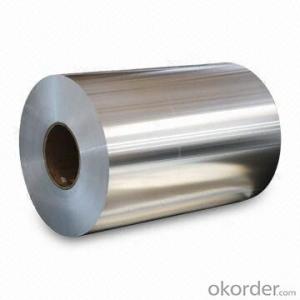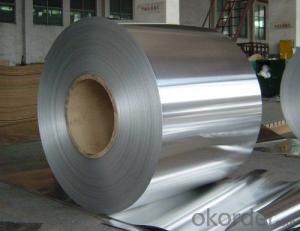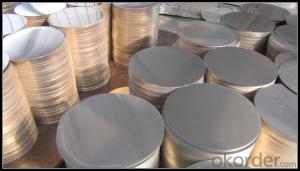Aluminum Coil Anodizing for Roofing Ceiling Decoration High Quality China
- Loading Port:
- Tianjin
- Payment Terms:
- TT OR LC
- Min Order Qty:
- 10000 m.t
- Supply Capability:
- 10000 m.t/month
OKorder Service Pledge
OKorder Financial Service
You Might Also Like
Specification
1.specializes of aluminum coils
Aluminum coil |
| |||||
Alloy | 1050,1060,1070,1100,1145,1235 | O,H12,H22,H14,H24,H16,H26,H18 | ||||
3003,3004,3014,3105,3102 | O,H12,H22,H14,H24,H16,H26,H18 | |||||
5052,5754,5005,5083 | O,H12,H22,H14,H24,H16,H26,H18 | |||||
8011 | O,H12,H22,H14,H24,H16,H26,H18 | |||||
Specification |
Kindly Notice:dimensions also can be produced as your party request | |||||
Packing:standard export packing,wooden pallet.
|
| |||||
Delivery Time | 30days after receiving your depoist or original L/C. | |||||
Minimum Order | 5 tons | |||||
The term of Payment | T/T, Irrevocable L/C at sight. | |||||
Application | Mainly used in Construction , decoration,packaging, printing, cover material,piping, electronic elements, referigeration, air conditioner, automobile, and so on.
| |||||
Surface | Mill Finish | |||||
Origin | Henan,China
| |||||
Aluminum coil |
| |||||
Alloy | 1050,1060,1070,1100,1145,1235 | O,H12,H22,H14,H24,H16,H26,H18 | ||||
3003,3004,3014,3105,3102 | O,H12,H22,H14,H24,H16,H26,H18 | |||||
5052,5754,5005,5083 | ||||||
8011 | O,H12,H22,H14,H24,H16,H26,H18 | |||||
Specification |
Kindly Notice:dimensions also can be produced as your party request | |||||
Packing:standard export packing,wooden pallet
| Eye to sky |
| ||||
Eye to Wall |
| |||||
Delivery Time | 30days after receiving your depoist or original L/C. | |||||
Minimum Order | 5 tons | |||||
The term of Payment | T/T, Irrevocable L/C at sight | |||||
Application | Mainly used in Construction , decoration,packaging, printing, cover material,piping, electronic elements, referigeration, air conditioner, automobile, and so on
| |||||
Surface | Mill Finish | |||||
Origin | Henan,China
| |||||
FAQ
Q: Do you have the CE, TUV, UL Certification?
A: We’ve already passed all the tests, and any certificate is available.
Q: Have you ever sold your products to companies in my country?
A: Of course, we have customers in all general PV markets, but I think we should expand our market share along with the market growth.
Q: How do you pack your products?
A: We have rich experience on how to pack to make sure the safety on shipment when it arrives at the destination.
Q: Can you do OEM for us?
A: Yes, we can.
Q: Can we visit your factory?
A: Surely, I will arrange the trip basing on your business schedule.
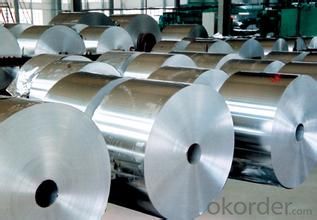
- Q: How are aluminum coils tested for mechanical properties?
- To evaluate the mechanical properties of aluminum coils, a range of standardized tests are conducted. These tests assess factors such as strength, ductility, and other relevant properties. Tensile testing, hardness testing, and bend testing are among the common methods used. Tensile testing is widely employed to analyze the mechanical properties of aluminum coils. This method involves subjecting a small portion of the coil to a pulling force until it fractures. Throughout the test, the force and elongation are measured to determine the coil's ultimate tensile strength, yield strength, and elongation at break. Another crucial evaluation method is hardness testing, which measures the coil's resistance to indentation or scratching. This test provides insights into the coil's ability to withstand external forces. Different hardness testing techniques, such as Brinell, Rockwell, and Vickers, can be utilized based on specific requirements. Bend testing is performed to evaluate the coil's ductility and formability. This process entails bending the coil to a specific angle or radius and inspecting it for any indications of cracking, wrinkling, or defects. Bend testing helps determine the coil's ability to undergo forming processes without failure. In addition to these standard tests, specialized testing methods can be employed to assess mechanical properties like fatigue resistance, impact resistance, and fracture toughness. These tests offer valuable information about the performance of the aluminum coil and ensure that it meets the required specifications and standards. In conclusion, a combination of tests is utilized to comprehensively evaluate the mechanical properties of aluminum coils, guaranteeing that they possess the necessary strength, ductility, and other properties essential for their intended applications.
- Q: What are the common surface treatments for aluminum coils in the automotive industry?
- In the automotive industry, aluminum coils undergo various surface treatments to enhance their performance and appearance. Some common surface treatments for aluminum coils in the automotive industry include: 1. Anodizing: Anodizing is a popular surface treatment for aluminum coils as it creates a protective oxide layer on the surface. This process involves immersing the coils in an electrolytic solution and passing an electric current through it. Anodizing provides corrosion resistance, improves durability, and allows for the application of dyes or paints. 2. Painting: Aluminum coils can be painted to provide an aesthetically pleasing appearance and protection against environmental factors. The coils are coated with a layer of paint, which can be solvent-based or powder-coated. Painting not only enhances the visual appeal but also adds a layer of protection against scratches and UV radiation. 3. Cladding: Cladding involves bonding a layer of aluminum alloy with different properties onto the surface of the coil. This treatment is commonly used to improve the strength, thermal conductivity, or corrosion resistance of the aluminum coil. Cladding can be done through various methods, such as hot rolling, cold rolling, or explosive bonding. 4. Clear Coating: Clear coating is often applied to aluminum coils to provide a transparent protective layer. This coating helps prevent corrosion, oxidation, and discoloration, while also preserving the natural metallic appearance of the aluminum coil. 5. Polishing and Buffing: Polishing and buffing are surface treatments that aim to enhance the surface smoothness and shine of aluminum coils. These treatments involve mechanically grinding or polishing the surface to remove imperfections, scratches, and oxidation. Polishing and buffing are commonly used for decorative purposes in high-end automotive applications. These are just a few of the common surface treatments for aluminum coils in the automotive industry. The choice of treatment depends on factors such as the desired appearance, performance requirements, and environmental conditions the coils will be exposed to.
- Q: Can aluminum coils be recycled?
- Indeed, it is possible to recycle aluminum coils. Due to its exceptional recyclability, aluminum stands as one of the frequently recycled materials. The procedure for recycling aluminum coils encompasses melting them to eliminate impurities and subsequently molding them into fresh products or coils. By recycling aluminum coils, not only are natural resources preserved, but also energy consumption and greenhouse gas emissions are diminished relative to the production of new aluminum from primary materials.
- Q: I am looking to bake some Buffalo wings and am wondering if it's alright to bake them in an aluminum pan (disposable or otherwise). I will be brushing/basting the chicken in the sauce not 'drowning' the chicken in it. I have heard that acidic sauces like Tomato sauce (less acidic than wing sauce) should not be cooked in aluminum (stovetop pans bakeware) because of some chemical interaction, but I've seen those big foil pans full of pasta spaghetti sauce at wedding, etc. Is the whole acid/aluminum thing true or an old cooking myth?
- The aluminum pan thing is NOT a myth. Short term storage in an aluminum pan for catering an event as described above is generally fine, however if you intend to store acidic foods for more than a couple hours then stainless steel or plastic is the way to go. The acids will eventually discolor the aluminum pan and in severe cases even eat completely through them. Personally I would advise that you deep fry the wings and then toss in a large bowl with enough sauce to coat the wings, not float them.
- Q: Can aluminum coils be used for pharmaceutical packaging?
- Yes, aluminum coils can be used for pharmaceutical packaging. Aluminum is a popular choice for pharmaceutical packaging due to its various beneficial properties. It is lightweight, corrosion-resistant, and has excellent barrier properties, making it ideal for protecting pharmaceutical products from external factors such as moisture, oxygen, and light. Aluminum coils can be easily formed into different shapes and sizes, providing versatility for packaging needs. Additionally, aluminum is non-toxic and non-reactive, ensuring the safety and integrity of pharmaceutical products.
- Q: What are the maximum operating temperatures for aluminum coils?
- The maximum operating temperatures for aluminum coils typically range from 300 to 400 degrees Fahrenheit, depending on the specific grade and alloy of aluminum being used.
- Q: What are the common surface defects or issues in aluminum coils?
- Aluminum coils may exhibit various surface defects or issues that can arise from different causes. These defects can have detrimental effects on the appearance, quality, and functionality of the coils. Therefore, it is crucial for manufacturers and users to be mindful of these defects and implement necessary measures to prevent or reduce their occurrence. Scratches, for instance, are visible marks on the coil surface that result from contact with abrasive materials or mishandling during production, transportation, or storage. Streaks, on the other hand, manifest as long, narrow lines or bands on the coil surface, often caused by irregularities in the rolling process or impurities present in the aluminum material. Dents are localized depressions or deformations that can occur due to mishandling, accidental impacts, or improper storage practices. Corrosion, though aluminum is generally resistant, can arise from specific environmental conditions or exposure to corrosive agents, leading to the formation of oxide layers or pitting on the coil surface. Edge cracks refer to fissures that appear along the coil edges, resulting from improper cutting or shearing during manufacturing. Surface roughness, characterized by an uneven or bumpy texture, can arise from inadequate smoothing or finishing during rolling or processing. Oil stains may be observed as dark or discolored areas on the coil surface, caused by improper cleaning or lubrication during production. Coil set refers to the coil's tendency to retain a curvature or shape after unwinding, resulting from stresses induced during rolling, coiling, or cooling, leading to an uneven and non-flat surface. Roll marks are patterns or imprints left on the coil surface by the rolling mill or equipment, caused by uneven pressure or improper tool alignment. Discoloration, characterized by changes in color or appearance, can result from exposure to high temperatures, chemical reactions, or oxidation. It is essential to recognize these surface defects and their potential impact on the quality and performance of aluminum coils. By taking appropriate preventive measures, manufacturers and users can minimize these defects and ensure the desired appearance and functionality of the coils.
- Q: What are the common sizes of aluminum coils available?
- The common sizes of aluminum coils available vary depending on the specific application and industry. However, some standard sizes include widths ranging from 36 inches (91 cm) to 72 inches (183 cm) and thicknesses between 0.019 inches (0.048 cm) to 0.125 inches (0.318 cm). These sizes are commonly used in industries such as construction, automotive, and manufacturing.
- Q: What is the cost involved in the production of an aluminum coil?
- <p>The cost to produce an aluminum coil varies significantly based on several factors. These include the cost of raw materials, energy costs for melting and rolling, labor, and overhead expenses. Additionally, the price of aluminum on the commodities market directly impacts the cost. As of recent market trends, the cost can range from a few hundred to several thousand dollars per ton, depending on the specific alloy and thickness of the coil. It's essential to consider the current market prices for aluminum and the efficiency of the production process when calculating the cost to produce an aluminum coil.</p>
- Q: I wrap everything with aluminum foil and bake it in the oven -- fish, meat, vegetables. Is this really safe? Or safe when done occasionally? Or should I find a new way?
- I use aluminium foil often for baking however I use baking paper between the food and the foil. I am sure it is safe to use foil, however I find that on occasions the foil sticks to the food, so I use the non stick paper between. I hope this helps.
Send your message to us
Aluminum Coil Anodizing for Roofing Ceiling Decoration High Quality China
- Loading Port:
- Tianjin
- Payment Terms:
- TT OR LC
- Min Order Qty:
- 10000 m.t
- Supply Capability:
- 10000 m.t/month
OKorder Service Pledge
OKorder Financial Service
Similar products
Hot products
Hot Searches
Related keywords
